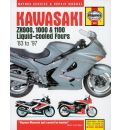
Kawasaki Zx900 1000 and 1100 Liquid-Cooled Fours Service and Repair Manual by Mark CoombsGet other Kawasaki Motorbike repair manuals hereHaynes offers the best coverage for cars trucks vans SUVs and motorcycles on the market today. Each manual contains easy to follow step-by-step instructions linked to hundreds of photographs and illustrations. Included in every manual: troubleshooting section to help identify specific problems; tips that give valuable short cuts to make the job easier and eliminate the need for special tools; notes cautions and warnings for the home mechanic; color spark plug diagnosis and an easy to use index. Integracar attempts to provide a extensive variety of service guides. Nevertheless owners manuals can sometimes be released for many different nations and the motorcycles engineered for those countries. For this reason not all workshop manuals may be appropriate for your particular motor bike. If you have any enquiries whether a specific maintenance manual is right for your motorbike feel free to contact us hereKawas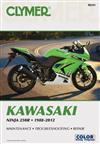
Softback – – Kawasaki Ninja 250r 1988 – 2012 Clymer Owners Service Repair Manual covers the EX250 Ninja 250R. Quick Reference Data General InformationManual Organization / Warnings Cautions And Notes / Safety / Serial Numbers / Fasteners / Shop Supplies / Tools / Measuring Tools / Electrical System Fundamentals / Service Methods / Storage / Specifications Specs TroubleshootingStarting The Engine / Engine Spark Test / Engine Performance / Electrical Testing / Starting System / Engine Noise / Motorcycle Noise / Engine Lubrication / Engine Leakdown Test / Clutch / Gear Shift Linkage And Transmission / Brakes / Steering And Handling / Brake Troubleshooting Specs Lubrication Maintenance And Tune-UpTune-Up / Air Filter / Engine Oil And Filter / Idle Speed Adjustment / Spark Plugs / Battery / Compression Test / Ignition Timing Inspection / Brake System / Clutch / Cooling System / Fuel Hose Inspection / Emission Control Systems / Throttle Cables / Choke Cable / Carburetor Synchronization / Tyres And Wheels / Valve Clearance / Lights And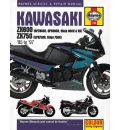
Kawasaki ZX600 and 750 Fours (85-97) Service and Repair Manual by Bob HendersonGet other Kawasaki Motorbike repair manuals hereHaynes offers the best coverage for cars trucks vans SUVs and motorcycles on the market today. Each manual contains easy to follow step-by-step instructions linked to hundreds of photographs and illustrations. Included in every manual: troubleshooting section to help identify specific problems; tips that give valuable short cuts to make the job easier and eliminate the need for special tools; notes cautions and warnings for the home mechanic; color spark plug diagnosis and an easy to use index. Integracar tries to make available a big array of repair guides. In spite of this work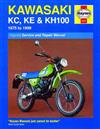
Softcover – 172 pages – Kawasaki KC/KE KH100 1975 – 1999 Haynes Owners Service Repair Manual Covers the following models:UK Models: KC100 (Companion) 99cc 1979 – 1986 KE100A 99cc 1978 – 1981 KH100A (KH100EL) 99cc 1977 – 1980 KH100G (KH100EX) 99cc 1981 – 1993USA Model: KE100A 99cc 1975 – 1981 KE100B 99cc 1981 – 1999Contents: Maintenance Engine Clutch And Transmission Fuel System And Lubrication Ignition System Frame And Forks Wheels Brakes And Tyres Electrical System Wiring Diagrams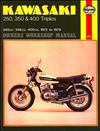
Softcover – 126 pages – Kawasaki 250 350 450 Triples 1972-1979 Haynes Owners Service Repair Manual Covers the following Models: S1 249cc 1972 – 1973 S1A 249cc 1973 S1B 249cc 1973 – 1974 S1C 249cc 1975 – 1976 KH250 249cc 1976 – 1979 S2 346cc 1971 – 1973 S3 400cc 1974 S3A 400cc 1975 – 1976 KH400 400cc 1976 – 1979Contents: Maintenance Engine Clutch And Transmission Fuel System And Lubrication Ignition System Frame And Forks Wheels Brakes And Tyres Electrical System Wiring Diagrams The Kawasaki KH250 And KH400 Models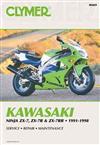
Softcover – 650 pages – Kawasaki Ninja ZX-7 ZX-7R ZX-7RR 1991 – 1998 Clymer Owners Service Repair Manual Covers the following Models: Ninja ZX-7 J1 J2 (U.S. Canada and U.K.) (1991-1992) Ninja ZX-7R K1 K2 (U.S. Canada and U.K.) (1991-1992) Ninja ZX-7 L1 L2 L3 (U.S. Canada and U.K.) (1993-1995) Ninja ZX-7R M1 M2 (U.S. Canada and U.K.) (1993-1994) Ninja ZX-7RR N1 (U.S. Canada and U.K.) (1996) Ninja ZX-7R P1 P2 P3 (U.S. Canada U.K. and Europe) (1996-1998)Contents: QUICK REFERENCE DATA GENERAL INFORMATIONManual organization / Notes cautions and warning / Safety first / Washing the bike/ Torque specifications / Special tips / Fasteners / Lubricants / Threadlocking compound / Expendable supplies / Serial numbers / Warning and information labels / Basic hand tools / Precision measuring tools / Special tools / Fabricating tools / Mechanic #39;s tips / Ball bearing replacement / Seals / Riding safely / Storage / Specifications TROUBLESHOOTINGOperating requirements / Troubleshooting in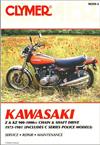
Softcover – 366 pages – Kawasaki Z1 KZ900 KZ1000 (incl. Police) Z1R 1973 – 1981 Clymer Owners Service Repair Manual Covers the following Models: Kawasaki Z1 1973-1974 Kawasaki KZ900 1975-1976 Kawasaki KZ1000 1977-1978 Kawasaki KZ1000 Standard 1979-1980 Kawasaki KZ1000 Classic 1980 Kawasaki KZ1000 LTD Limited 1977-1980 Kawasaki Z1R 1978-1980 Kawasaki KZ1000C Series Police 1978-1981Contents: QUICK REFERENCE DATA GENERAL INFORMATIONManual organization / Service hints / Safety first / Expendable supplies / Shop tools / Emergency tool kit /Troubleshooting and tune-up equipment / Specifications TROUBLESHOOTINGStarting difficulties / Poor performance / Clutch and transmission / Drive train / Chassis / Electrical system / Charging system / Lighting / Fuses / Wiring LUBRICATION MAINTENANCE AND TUNE-UPScheduled maintenance / Weekly maintenance / Drive chain adjustment / Throttle adjustment/ Chain oil pump adjustment / Monthly maintenance / Six month maint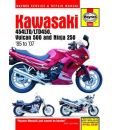
Kawasaki 450 and 500 by Alan AhlstrandGet other Kawasaki Motorbike repair manuals hereWith a Haynes manual you can do it yourself…from simple maintenance to basic repairs. Haynes writes every book based on a complete teardown of the motorcycle. We learn the best ways to do a job and that makes it quicker easier and cheaper for you. Our books have clear instructions and plenty of photographs that show each step. Whether you re a beginner or a pro you can save big with Haynes! – Step-by-step procedures – Easy-to-follow photos – Complete troubleshooting section – Valuable short cuts – Color spark plug diagnosis Complete coverage for your Kawasaki EN450 and 500 Twins covering EN450 (454LTD/LTD450) for 1985 to 1990 EN500 or Vulcan 500 for 1990 to 2007 and EX250 or Ninja 250 for 1986 to 2007: – Routine Maintenance – Tune-up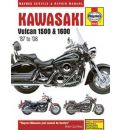
Kawasaki Vulcan 1500 1600 Service and Repair Manual by Matthew CoombsGet other Kawasaki Motorbike repair manuals hereWith a Haynes manual you can do it yourself #133;from simple maintenance to basic repairs. Haynes writes every book based on a complete teardown of the motorcycle. We learn the best ways to do a job and that makes it quicker easier and cheaper for you. Our books have clear instructions and hundreds of photographs that show each step. Whether you re a beginner or a pro you can save big with Haynes! Integracar aims to provide a wide range of owners manuals. On the other hand maintenance manuals could well be designed for multiple nations and the motorcycles engineered for those nations. Due to this fact not all service manuals may be appropriate for your selected motorbike. If you have any important questions whether or not a sele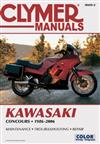
Softcover – 450 pages – Kawasaki ZG1000 Concours GTR1000 1986 – 2006 Clymer Owners Service Repair Manual Covers the following Models: Kawasaki Concours ZG1000 1986 – 2006 Kawasaki Concours GTR1000 1986 – 2006Contents: QUICK REFERENCE DATA GENERAL INFORMATIONManual organization / Warnings cautions and notes / Safety / Serial numbers / Fasteners / Shop supplies / Basic tools / Precision measuring tools / Electrical system fundamentals / Basic service methods / Storage / Specifications TROUBLESHOOTINGOperating requirements / Starting the engine / Starting difficulties / Engine performance / Engine noises / Engine lubrication / Engine leakdown test / Clutch / Fuel system / Gearshift linkage / Transmission / Final drive / Electrical testing / Charging system / Ignition system / Starting system / Cooling system / Front suspension and steering / Brakes LUBRICATION MAINTENANCE AND TUNE-UPMaintenance schedule intervals / Spark plugs / Engine compression test / Ignition timing / Valve clearance / Engine oil and filter / Air filter / Throttle and choke cable / General lubrication / Emiss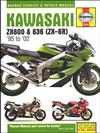
Hardcover – 288 pages – Kawasaki ZX600 636 (ZX-6R) 1995 – 2002 Haynes Owners Service Repair Manual Covers the following models:US models: Kawasaki ZX600F 1995-1997 Kawasaki ZX600G 1998-1999 Kawasaki ZX600H 1998 Kawasaki ZX600J 2000-2002UK and Europe models: Kawasaki ZX600F 1995-1997 Kawasaki ZX600G 1998-1999 Kawasaki ZX600H 1998 (except UK) Kawasaki ZX600J 2000-2001 Kawasaki ZX636A 2002Contents: Kawasaki Zx600 636 (Zx-6r) Maintenance Introduction- Engine/Transmission Oil Level Check- Brake Fluid Level Checks- Specifications- Recommended Lubricants And Fluids- Maintenance Schedule- Component Locations- Maintenance Procedures Repairs And OverhaulEngine Transmission And Associated Systems- Engine Clutch And Transmission- Fuel And Exhaust Systems- Ignition System- Fuel And Exhaust System- Ignition Systems Chassis Components- Frame And Suspension- Final Drive- Brakes- Tyres- Fairing And Bodywork Electrical System; Wiring Diagrams Reference- Tools And Workshop Tips- Storage- Troubleshooting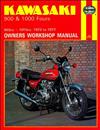
Softcover – 152 pages – Kawasaki 900 1000 Fours 1973 – 1977 Haynes Owners Service Repair Manual covers the following models:UK Models: Z1 903cc 1973 – 1976 Z900 903cc 1976 Z1000 1015cc 1976 – 1977USA Models: Z1 903cc 1973 – 1975 KZ900 903cc 1975 – 1977 KZ1000 1015cc 1976 – 1977Contents: Maintenance Engine Clutch Transmission: Dismantling Reassembly Fuel System And Lubrication: Air Cleaner Carburetors Chain Lubrication Ignition System: Condensers Contact Breakers Alternator Spark Plugs Frame And Forks: Examination Renovation Wheels Brakes And Tyres Electrical System: Alternator Battery Fuses Voltage Regulator Wiring Diagrams The Z900 And Z1000 Models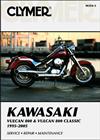
Softcover – 400 pages – Kawasaki VN800 Vulcan Vulcan Classic 1995 – 2005 Clymer Owners Service Repair Manual covers the following models: Kawasaki Vulcan 800 VN800A 1995 – 2005 Kawasaki Vulcan Classic VN800B 1996 – 2005Note: This manual DOES NOT cover VN800C/E Drifter models.Contents: Quick Reference Data General InformationManual Organization / Notes Cautions And Warnings / Safety First / Service Hints / Washing The Bike / Special Tips / Torque Specifications / Fasteners / Lubricants / Rtv Gasket Sealant / Gasket Remover / Threadlocking Compound / Expendable Supplies / Serial Numbers / Warning And Information Labels / Basic Hand Tools / Precision Measuring Tools / Special Tools / Fabricating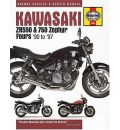
Kawasaki ZR550 and 750 Zephyr Fours (90-97) Service and Repair Manual by Matthew CoombsGet other Kawasaki Motorbike repair manuals hereThere is a Haynes manual for most popular domestic and import cars trucks and motorcycles. By conducting complete tear-downs and rebuilds the Haynes staff has discovered all the problems owners will find in rebuilding or repairing their vehicle. Documenting the process in hundreds of illustrations and dear step-by-step instructions makes every expert tip easy to follow. From simple maintenance to trouble-shooting and complete engine rebuilds it s easy with Haynes. Integracar tries to have a substantial array of maintenance manuals. All the same workshop manuals can sometimes be prepared for a range of nations and the motorbikes produced for those countries. Hence not all repair manuals may be best suited for your particular motorcycle. If you have enquiries whether a selected maintenance manual is ideal for your vehicle kindly get in touch with us hereKawasaki ZR550 and 750 Ze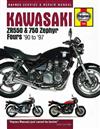
Hardcover – 272 pages – Kawasaki ZR550 750 Zephyr 1990 – 1997 Haynes Owners Service Repair Manual Covers the following models: Kawasaki Zephyr ZR550 Four UK/US 1990 – 1997 Kawasaki Zephyr ZR750 Four UK/US 1990 – 1997 Kawasaki Zephyr ZR550B UK 1991 – 1997 US 1990 – 1993 Kawasaki Zephyr ZR750C UK 1991 – 1996 US 1991 – 1993 Kawasaki Zephyr ZR750D UK 1996 – 1997Contents: Living With Your Kawasaki ZR550 ZR750 Zephyr- Identification Numbers- Buying Spare Parts- Pre-Ride Checks- Engine Oil Level- Brake Fluid Levels- Tyres- Bike Specs MAINTENANCE- Routine Maintenance And Servicing- Specifications- Lubricants And Fluids- Maintenance Schedule- Component Locations- Maintenance Procedures REPAIRS AND OVERHAUL- Engine Clutch And Transmission- Fuel And Exhaust Systems- Ignition System- Frame And Suspension- Brakes Wheels And Final Drive- Fairing And Bodywork- Electrical System- Wiring Diagrams REFERENCE- Tools And Workshop Tips- Security- Storage- Troubleshooti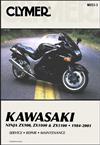
Softcover – 610 pages – Kawasaki Ninja ZX900 ZX1000 ZX1100 1984 – 2001 Clymer Owners Service Repair Manual Covers the following Models: Ninja ZX900 A1-A3 (1984-1986) Ninja ZX1000 A1-A2 (1986-1987) Ninja ZX1000 (ZX-10) B1-B3 (1988-1990) Ninja ZX1100 C1-C4 (1990-1993) Ninja ZX1100 (ZX-11) D1-D9 (1993-2001)Contents: QUICK REFERENCE DATA GENERAL INFORMATIONManual organization / Notes cautions and warnings / Safety first / Service hints / Torque specifications / Fasteners / Lubricants / Parts replacement / Basic hand tools / Test equipment / Mechanic #39;s tools / Specifications TROUBLESHOOTINGoperating requirements / Troubleshooting instruments / Starting the engine / Emergency troubleshooting / Engine starting / Engine performance / Engine noises / Engine lubrication / Excessive exhaust smoke / Clutch /Transmission / Electrical troubleshooting / Test equipment / Basic test procedures / Charging system troubleshooting / Ignition system / Starting sys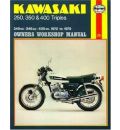
Kawasaki 250 350 and 400 Three Cylinder Owner s Workshop Manual by Frank MeekGet other Kawasaki Motorbike repair manuals hereHaynes disassembles every subject vehicle and documents every step with thorough instructions and clear photos. Haynes repair manuals are used by the pros but written for the do-it-yourselfer. Integracar endeavors to make available a wide diversity of maintenance manuals. But repair manuals may just be put together for a range of countries and the vehicles delivered for those nations. And thus not all owners manuals may be fitting for your selected motorbike. If you have questions whether a specific workshop manual is ideal for your motorbike feel free to e-mail us hereKawasaki 250 350 and 400 Three Cylinder Owner s Workshop Manual by Frank Meek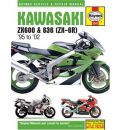
Kawasaki ZX-6R Service and Repair Manual by Matthew CoombsGet other Kawasaki Motorbike repair manuals hereEvery Haynes motorcycle manual is based on a complete teardown and rebuild and contains hundreds of photos with step-by-step instructions comprehensive routine maintenance and troubleshooting information and detailed wiring diagrams. Integracar tries to offer a wide selection of owners guides. Nonetheless service manuals can possibly be designed for completely different countries and the motor cycle developed for those countries. Accordingly not all maintenance manuals may be desirable for your particular vehicle. If you have questions whether or not a specific workshop manual is desirable for your vehicle kindly e-mail us hereKawasaki ZX-6R Service and Repair Manual by Matthew Coombs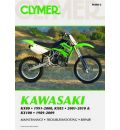
Clymer Kawasaki KX80 1991-2000 KX85 2001-2010 and KX100 1989-2009 by Mike MorlanGet other Kawasaki Motorbike repair manuals hereMaintenance troubleshooting repair–Cover. Integracar attempts to provide you with a big collection of servicing manuals. But service manuals can be produced for completely different countries and the motorcycles designed for those nations. So not all maintenance manuals may be acceptable for your individual vehicle. If you have questions whether or not a particular repair manual is relevant for your motorcycle do not hesitate to e-mail us hereClymer Kawasaki KX80 1991-2000 KX85 2001-2010 and KX100 1989-2009 by Mike Morlan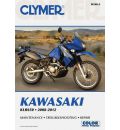
Clymer Kawasaki KLR650 2008-2012 by Mike MorlanGet other Kawasaki Motorbike repair manuals hereMaintenance troubleshooting repair–Cover. Integracar attempts to offer a wide assortment of repair guides. Even so service manuals may just be manufactured for alternate nations and the motorbikes designed for those countries. Thereby not all repair manuals may be applicable for your specific vehicle. If you have queries whether a specific service manual is accurate for your motor bike feel free to get in touch with us hereClymer Kawasaki KLR650 2008-2012 by Mike Morlan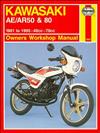
Softcover – 117 pages – Kawasaki AE/AR 50 80 1981 – 1995 Haynes Owners Service Repair Manual Covers the following models:UK Models: AE50A 49cc 1981 – 1985 AR50A 49cc 1981 – 1983 AR50C 49cc 1983 – 1995 AE80A 78cc 1981 – 1983 AE80B 78cc 1983 – 1987 AR80A 78cc 1981 – 1983 AR80C 78cc 1983 – 1992USA Models: AR50A 49cc 1981 – 1982 AR80A 78cc 1981 – 1982Contents: Introduction To The Kawasaki AE/AR50 And 80 Models Ordering Parts Tools And Work Area Routine Maintenance Engine Clutch And Transmission Fuel System And Lubrication Ignition System Frame And Forks Wheels Brakes And Tyres Electrical System Wiring Diagrams The 1984-On Models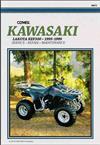
Softcover – 362 pages – Kawasaki Lakota KEF300 1995 – 1999 Clymer Owners Service Repair Manual covers KEF300 Lakota (1995-1999)Contents: QUICK REFERENCE DATA GENERAL INFORMATIONManual organization / Notes cautions and warnings / Safety first / Service hints / Washing the vehicle / Special tips / Torque specifications / Fasteners / Lubricants / RTV gasket sealant / Gasket remover / Threadlocking compound / Expendable supplies / Serial numbers / Warning and information labels / Basic hand tools / Precision measuring tools / Test equipment / Special tools / Fabricating tools / Mechanic #39;s tips / Bearing replacement / Seals / Riding safety / Specifications TROUBLESHOOTINGOperating requirements / Troubleshooting instruments / Starting the engine / Starting difficulties / Engine starting troubles / Engine is difficult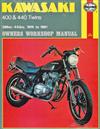
Softcover – 185 pages – Kawasaki 400 440 Twins 1974 – 1981 Haynes Owners Service Repair Manual Covers the following Models:UK Models: KZ400 398cc 1975 – 1976 Z400D 398cc 1976 – 1979 Z400B 398cc 1978 – 1980 Z400G 398cc 1979 – 1980 Z440A 443cc 1981 Z440C 443cc 1980 – 1981USA Models: KZ400 398cc 1974 – 1976 KZ400S 398cc 1975 – 1977 KZ400D 398cc 1975 – 1977 KZ400B 398cc 1978 – 1979 KZ400C 398cc 1978 KZ400H 398cc 1979 KZ440A 443cc 1980 – 1981 KZ440B 443cc 1980 – 1981 KZ440D 443cc 1980 – 1981Contents: Maintenance Engine Clutch And Transmission Fuel System And Lubrication Ignition System Frame And Forks Wheels Brakes And Tyres Electrical System Including Wiring Diagrams Kawasaki 400 And 440 1977 To 1981 Models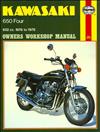
Softcover – 132 pages – Kawasaki Z650 KZ650 Fours 1976 – 1978 Haynes Owners Service Repair Manual Covers the following models: Kawasaki Z650B1 (Z650) U.K. October 1976-on Kawasaki KZ650B1 (KZ650) U.S. September 1976-onContents: Maintenance Engine Clutch Transmission Fuel System And Lubrication Ignition System Frame And Forks Wheels Brakes And Tyres Electrical System Wiring Diagrams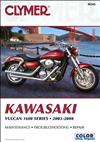
Softcover – 462 pages – Kawasaki Vulcan 1600 Classic Mean Streak Nomad 2003 – 2008 Clymer Owners Service Repair covers the following models: Kawasaki Vulcan VN1600 Classic A E 2003-2008 Kawasaki Vulcan VN1600 Mean Streak B F 2004-2008 Kawasaki Vulcan VN1600 Nomad D G 2005-2008Contents: QUICK REFERENCE DATA GENERAL INFORMATIONManual organization / Warnings cautions and notes / Safety / Serial numbers and information labels / Fasteners / Shop supplies / Tools / Measuring tools / Electrical system fundamentals / Service methods / Storage / Specifications TROUBLESHOOTINGStarting the engine / Engine does not start / Poor engine performance / Electronic diagnostic system / Fuel system / Engine / Engine lubrication / Cylinder leakdown test / C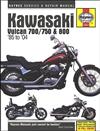
Hardcover – 256 pages – Kawasaki Vulcan 700/750 800 1985 – 2004 Haynes Owners Service Repair Manual Covers the following models: Kawasaki Vulcan 700 1985 Kawasaki Vulcan 750 1985-2004 Kawasaki Vulcan 800 1995-2004 Kawasaki Vulcan 800 Classic 1996-2002 Kawasaki Vulcan 800 Drifter 1999-2004Contents: Living With Your Kawasaki Vulcan Introduction- Identification Numbers- Buying Parts Daily (Pre-Ride) Checks- Engine/Transmission Oil Level Check- Brake Fluid Level Checks- Suspension Steering And Final Drive Checks- Tyre Checks Maintenance- Routine Maintenance And Servicing- Specifications- Maintenance Schedule- Component Locations- Maintenance Procedures Repairs And Overhaul- Engine Transmission And Associated Systems- Engine Clutch And Transmission- Cooling System- Fuel And Exhaust Systems- Ignition System Chassis Components- Steering- Suspension- Final Drive- Whee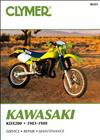
Softcover – 296 pages – Kawasaki KDX200 1983 – 1988 Clymer Owners Service Repair Manual covers Kawasaki KDX200 dual-sport bike 1983 to 1988.Contents: QUICK REFERENCE DATA GENERAL INFORMATIONManual organization / Notes cautions and warnings / Safety first / Service hints / Engine operation / Washing the bike / Torque specifications / Fasteners / Lubricants / RTV Gasket sealant / Threadlock / Parts replacement / Optional parts / Basic hand tools / Precision measureing tools / Special tools / Fabricating tools / Expendable supplies / Mechanic #39;s tips / Safety / Specifications TROUBLESHOOTINGOperating requirements / Troubleshooting instruments / Starting the engine / Starting difficulties / Engine starting trouble / Engine / Engine performance / Engine noises / Excessive vibration / Fuel system / Two-stroke pressure testing / Clutch /Transmission / Ignition system / Front suspen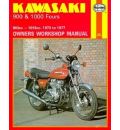
Kawasaki 900 and 1000 1972-77 Owner s Workshop Manual by G. CollettGet other Kawasaki Motorbike repair manuals hereInside this manual you will find routine maintenance tune-up procedures engine repair cooling and heating air conditioning fuel and exhaust emissions control ignition brakes suspension and steering electrical systems and wiring diagrams. Integracar attempts to put up a significant scope of maintenance manuals. On the other hand workshop manuals could well be developed for distinctive nations and the motor cycle built for those countries. Which means not all workshop manuals may be desirable for your individual motor bike. If you have any enquiries whether a certain workshop manual is best suited for your motor bike do not hesitate to e-mail us hereKawasaki 900 and 1000 1972-77 Owner s Workshop Manual by G. Collett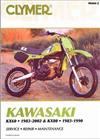
Softcover – 348 pages – Kawasaki KX60 KX80 1983 – 2002 Clymer Owners Service Repair Manual Covers the following Models: KX60 (1983-2002) KX80 (1983-1990)Contents: QUICK REFERENCE DATA GENERAL INFORMATIONManual organization / Notes cautions and warnings / Safety first / Service hints / Engine operation / Washing the bike / Torque specifications / Fasteners / Lubricants / RTV Gasket sealant / Threadlock / Parts replacement / Optional parts / Basic hand tools / Precision measureing tools / Special tools / Fabricating tools / Expendable supplies / Mechanic #39;s tips / Safety / Specifications TROUBLESHOOTINGOperating requirements / Troubleshooting instruments / Starting the engine / Starting difficulties / Engine starting trouble / Engine / Engine performance / Engine noises / Excessive vibration / Fuel system / Tow-stroke pressure testing / Clutch /Transmission / Ignition system / Front suspension and steering / Brakes LUBRICATION MAINTENANCE AND TUNE-UPPre-checks / Engine lubrication / Periodic lubrication / Periodic m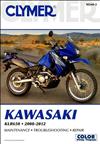
Softcover – 302 pages – Kawasaki KLR650 2008 – 2012 Clymer Owners Service Repair Manual covers Kawasaki KLR650.Contents: QUICK REFERENCE DATA GENERAL INFORMATIONManual organization / Warnings cautions and notes / Safety / Serial numbers / Fasteners / Shop supplies / Tools / Measuring tools / Electrical system fundamentals / Service methods / Storage / Specifications TROUBLESHOOTINGStarting the engine / Engine spark test / Engine performance / Electrical testing / Starting system / Engine noise / Motorcycle noise / Engine lubrication / Engine leakdown test / Clutch / Gear shift linkage and transmission / Brakes / Steering and handling / Disc brake troubleshooting / Specifications LUBRICATION MAINTENANCE AND TUNE-UPPre-ride inspection / Tune-up service and maintenance intervals / Fuel and lubricants / Oil and filter change / Fork oil change / Control cable lubrication / Drive chain cleaning lube and adjustment / Air filter cleaning and replacement / Air filter housing draining / Muffler cleaning / Balancer chain tensioner adjustment / Coolant level check / Coolant draining refill / Throttle play adjustment and inspection / Valve clearan
Keywords: Kawasaki Zx900, 1000 and 1100 Liquid-Cooled Fours Service and Repair Manual
Keywords: Kawasaki Ninja 250R 1988 – 2012 Clymer Owners Service and Repair Manual
Keywords: Kawasaki ZX600 and 750 Fours (85-97) Service and Repair Manual
Keywords: Kawasaki KC/KE and KH100 1975 – 1999 Haynes Owners Service and Repair Manual
Keywords: Kawasaki 250, 350 and 450 Triples 1972-1979 Haynes Owners Service and Repair ManualKawasaki S1, …
Keywords: Kawasaki Ninja ZX-7, ZX-7R and ZX-7RR 1991 – 1998Clymer Owners Service and Repair Manual
Keywords: Kawasaki Z1, KZ900, KZ1000 (incl. Police), Z1R 1973 – 1981Clymer Owners Service and Repair Manual
Keywords: Kawasaki 450 and 500
Keywords: Kawasaki Vulcan 1500 and 1600 Service and Repair Manual
Keywords: Kawasaki ZG1000 Concours and GTR1000 1986 – 2006Clymer Owners Service and Repair Manual
Keywords: Kawasaki ZX600, 636 (ZX-6R) 1995 – 2002 Haynes Owners Service and Repair Manual
Keywords: Kawasaki 900 and 1000 Fours 1973 – 1977 Haynes Owners Service and Repair Manual
Keywords: Kawasaki VN800 Vulcan, Vulcan Classic 1995 – 2005Clymer Owners Service and Repair Manual
Keywords: Kawasaki ZR550 and 750 Zephyr Fours (90-97) Service and Repair Manual
Keywords: Kawasaki ZR550 and 750 Zephyr 1990 – 1997 Haynes Owners Service and Repair Manual
Keywords: Kawasaki Ninja ZX900, ZX1000, ZX1100 1984 – 2001Clymer Owners Service and Repair Manual
Keywords: Kawasaki 250, 350 and 400 Three Cylinder Owner s Workshop Manual
Keywords: Kawasaki ZX-6R Service and Repair Manual
Keywords: Clymer Kawasaki KX80 1991-2000, KX85 2001-2010 and KX100 1989-2009
Keywords: Clymer Kawasaki KLR650 2008-2012
Keywords: Kawasaki AE/AR 50 and 80 1981 – 1995 Haynes Owners Service and Repair Manual
Keywords: Kawasaki Lakota KEF300 1995 – 1999 Clymer Owners Service and Repair Manual
Keywords: Kawasaki 400 and 440 Twins 1974 – 1981 Haynes Owners Service and Repair Manual
Keywords: Kawasaki Z650, KZ650 Fours 1976 – 1978 Haynes Owners Service and Repair Manual
Keywords: Kawasaki Vulcan 1600 Classic, Mean Streak and Nomad 2003 – 2008Clymer Owners Service and Repair
Keywords: Kawasaki Vulcan 700/750 and 800 1985 – 2004 Haynes Owners Service and Repair Manual
Keywords: Kawasaki KDX200 1983 – 1988 Clymer Owners Service and Repair Manual
Keywords: Kawasaki 900 and 1000 1972-77 Owner s Workshop Manual
Keywords: Kawasaki KX60 and KX80 1983 – 2002 Clymer Owners Service and Repair Manual
Keywords: Kawasaki KLR650 2008 – 2012 Clymer Owners Service and Repair Manual
Generational revisions
While performance specifications stays constant for all particular brands, some distinctions may affect non-American designs such as for example frame and plastic color, metal gas container, oil injections, functions particularly blinker lights, large result coil/stator, power rack, baggage rack, etc.
KDX200 “A” (1983-1985)
KDX200 “B” (1984-1985) runs concurrently with a design variations unconfirmed – perhaps neighborhood markets changes.
Very First KDX200. 198cc motor upped from preceding 173cc.
-Gain in displacement amount is by extended swing; Bore diameter continues to be the same as the 175.
-New gear ratios in six-speed transmission, another clutch plate added(7 from 6)
-Chassis predicated on 1983 KX125; steel tubing, box-section aluminum swingarm,
-Adjustable damping aluminum surprise, 38mm Kayaba forks,
-Electronic odometer
-1984(A2) obtainable in green, or black frame with purple synthetic
-1985 – newer 34mm Mikuni “R” fall carburetor
Standards for 1983-1985 U.S. Model engine-type Single-cylinder, air-cooled, two-stroke
Carburetion 34mm Mikuni carb
Displacement 198cc
Bore Stroke 66.0 x 58.0 mm
Compression Ratio 7.7 : 1
Fuel Capacity 12.5 Litres
Oil Capacity 0.7L / (0.74 US qt)
Seat Height N/A
Dry Pounds 101 kg
Tires Front: 80/100-21 Right Back: 110/100-18
Brake system Front: Single 221mm disc back once again: 110mm drum
Best drive 6 rate / string
KDX200 “C” (1986-1988)
1987 KDX200
Brand new KIPS powervalve program, latest 43mm conventional forks, brand-new rear shock, front disk braking system
Requirements for 1986-1988 U.S. design engine-type Single-cylinder, air-cooled, two-stroke piston and reed device
Carburetion Mikuni VM34SS
Displacement 198 mL (12.08 cu in)
Bore Stroke 66.0×58.0 mm (2.60 X 2.28 in)
Compression Proportion 7.7:1
Gas Capacity 12.5L (3.3 US girl)
Oil ability 700 mL (0.74 US qt)
Chair Level N/A
Dry pounds 101 kg (223 pound)
Tires 80/100 – 21 51M (front side), 100/100 -18 59M (rear)
Brake system Front: Disk braking system diameter 220 mm (8.7 in) backside: Internal broadening, leading trailing 110X30 mm (4.3X1.2 in)
Final drive 3.692 (48X13)
KDX200 “E” (1989-1994)
1993 KDX200-E
KDX200 SR model
Many crucial upgrades stumbled on the KDX200 in 1989. It received fluid air conditioning, an altered powervalve system with larger development bottle and valves, a heavier crank, twin disk brake system, heavy clutch springs and much more dishes, a recently modeled framework with a contemporary style linkage, KX125-based surprise with 16 compression and 16 rebound modifications, fast release access for backside wheel, big airbox, and a 12.0 litres (2.6 imp girl; 3.2 US girl) gas container.
-41 mm upside down forks emerged standard in 93 and 94 systems
Requirements for 1989-1994 U.S. design Engine Type Single-cylinder, liquid-cooled, two-stroke piston reed valve
Carburetion Keihin PWK-35
Displacement 198cc
Bore Stroke 66.0 x 58.0 mm
Compression Ratio 7.7:1 (high speed) 9.2:1 (lowest speed)
Gas Ability 12.0L
Oil capability SAE 10w30 or 10w40 0.75L
Chair level 910mm
Dry Weight 102 kg
Tires(tube) front side: 80/100-21 51mm right back: 100/100-18 59mm
Brake system forward and back: solitary piston; disk
Final drive string drive; 3.625 (47/13)
KDX200 “H” (1995-2006)
2005 KDX200-H
Notes: 1995 brought a contemporary fresh look and a redesigned KIPS powervalve system like larger valves and a main powervalve in the fatigue manifold.
-First perimeter frame
-43mm Kayaba cartridge kind forks
-higher compression
-Larger radiators
-Larger clutch
-Taller seat
Specifications for 1995-2006 U.S. Model engine-type Single-cylinder, fluid cooled, two-stroke
Carburetion Keihin PWK35
Displacement 198cc
Bore Stroke 66 x 58 mm (oversquare – shortstroke)
Compression Ratio 9.4:1
Gasoline Capacity 11 Litres
Oils Capability 0.75L
Seat Height 920mm
Handle-Bar level 1229mm
Circumference 889mm
Dry weight 109 kg
Tires Front:80/100-21 Back: 100/100-18
Brakes front side: solitary 250mm disk 2 piston caliper Back: Single 230mm disk 1 piston caliper
Best drive 6 speeds / sequence
The KDX200 spotted its final production run in 2006, with left models for sale through 2007 and into middle 2008 in a few areas.
The KX100 try a 2-stroke bike made by Kawasaki. The bicycle offers an excellent change between your conventional 85cc bikes as well as the 125cc bicycles by having bigger tires (19 inches front side, 16 inch back, in comparison to 17/14 of normal 85’s). Their predecessor may be the KX80 Bigwheel, that will be however sold in the united kingdom in title “KX85 II”. Longer vacation suspension system and bigger bore dimensions biggest differences when considering these bikes which usually are exactly the same.
The KX100 are raced in devoted 100cc motocross courses, or available minicycle courses, such as for example Supermini in Canada, allowing around 150cc 4-strokes and 85cc-112cc 2-strokes as of 2007. The KX100 can be raced within the 125cc class but 100cc bicycles aren’t quite typical.
The Kawasaki KX 250F try a liquid-cooled DOHC 249 cc (15.2 cu in) four-valve four-stroke solitary motocross bike made by Kawasaki.
The Kawasaki KX250F was co-developed with the Suzuki Motor Co. under their particular partnership that were only available in 2002. This jv produced the Suzuki RMZ250 the technical twin to your KX250F it is in yellowish Suzuki markings. Initial seasons associated with KX250F ended up being 2004 and it also saw immediate profits in Supercross and Motocross rushing catching the East/West SX titles plus the national MX subject.
The 2006 model year, Kawasaki took a unique split course in 250F development by releasing a new cycle which had no connections with Suzuki. The 2006 design qualities an all new aluminum perimeter framework, a heavily modified motor, newer Showa front side and back suspensions, and Renthal handlebars. The latest KX was very competitive, standing extremely in motocross magazine shootouts as well as in competitors. The 2008 KX250F have continuing its character as good bicycle, becoming respected in all dirtbike shootouts.
Last year, Kawasaki overhauled the KX250F with significantly more than a new look. These include many motor improvements to increase energy and conserve pounds, improvements into the suspension system, like a titanium layer to lessen rubbing, and some framework changes which help improve cornering and create a general slimmer experience.
Last year, Kawasaki added two newer significant features. 1st was an electronic digital gas injections (DFI) program. This technique had been similar to the one found on the stronger KX450F. It considerably better engine response some time paid down doubt whenever getting after a jump. The second inclusion is Showa’s split features hand (SFF). These brand-new forks decreased weight, improved efficiency, and let for smoother adjustability. In 2012, an additional fuel injector was added increasing horse power throughout the 2011 design.
Kawasaki again refurbished the KX250F in 2013. They developed an innovative new look with improvements towards fuel injections system and split work forks.
Kawasaki ended up being the past regarding the larger four Japanese makers to start creating motorcycles. In 1960 they purchased a share in the Meguro motorcycle business that since the 1930s had made four-stroke singles to 500 cc and later twins as much as 650 cc when it comes to Japanese and south-east Asian markets. From 1963 Kawasaki took complete control of Meguro, and Meguro model K 500 cc four-stroke parallel-twin was re-badged as a Kawasaki.
The Kawasaki W1 650 cc (in fact 624 cc) four-stroke twin was developed from the Meguro K-series, which Meguro have developed from a BSA A7 under license.
Kawasaki created the lighter Kawasaki A1 Samurai in 1966. It was quickly accompanied by the larger bore design, the A7 Avenger, which will be much like the Samurai. Revealing all Samurai equipment regardless of pistons, piston bands, various mufflers with reverse cones, in addition it showcased a race developed oiling system labeled as Injectolube. Oil wasn’t only inserted in using the petrol as from the 250 but has also been given towards the biggest bearings. The crankcases and crank were in addition redesigned for usage using the Injectolube program.
The A7SS Avenger has a crossover twin exhaust attached to the remaining side and just below the chair. Except that exhaust program, there have been hardly any other changes amongst the standard A7 and A7SS.
Motor
The motor had been advanced level for the time, with features ordinarily seen on race bicycles: two-cylinder, two-stroke, air-cooled, oil injected, twin rotary valve. While various other manufactures have used some great benefits of rotary disk device induction on little single-cylinder devices, best Kawasaki and Bridgestone produced twin-cylinder machines. Rotary disc valve induction means that the all the fuel fee is used and never partly lost (such as a piston ported motor). Thus, it creates additional energy, most torque at reduced revs and best response through the rev range. The engine’s initial environment offer started in an air filter canister below the seat and was attracted through a big plenum chamber just above the transmission and behind the cylinder mind, after that down into the internal passages ultimately causing the carburetor housing feeding the carburetors.
The A7 Avenger have two Mikuni carburetors located on the system’s remaining and right side and in line using crankshaft. The carburetors had been enclosed and secure through the elements by carburetor protects fixed into crankcase. Inboard of each carburetor, and support each carburetor, was the disc address. The rotary disk valve had been housed inboard of that address. In 1969 the ignition system was loaded with a capacitor discharge ignition including thyristor-based flipping system after that increasing the current to between 25,000 and 30,000 volts decreasing the unburned fuel combination inside the cylinders.
Through the development of the Kawasaki H1 Mach III, engineers considered using the Avenger’s twin-cylinder engine annoyed off to create the brand-new 500 cc two-stroke power-plant since needed in N100 Arrange.
Since 2008, the bicycle try sold since the Ninja 250R in every markets. It is also described by its platform designation, EX250, to which a generational suffix are connected. In the us, earlier versions (EX250-E/F/G/H) are currently being promoted as people in the Ninja group of sport bikes, while outside the U.S. the bike is recognized variously whilst the ZZR-250, ZX-250, or because the GPX-250R. One of many very first models, the EX250-C, was given the name GPZ-250.
Design records
The Ninja 250 is well-known in motorcycle classes
Cleaning the sequence on a Ninja 250R
The Ninja 250R’s particular ergonomics, framework design, and motor positioning have actually lead to a bike that straddles the conventional and recreation courses. The Ninja’s riding pose also drops between traditional and athletics.
1983
The first generation had been created between 1983 and 1985, and known because of the manufacturing quantity EX250-C. It was marketed while the GPZ-250. Sold best in its market of Japan, this very first, belt-driven variation was stated in 1983, and shares no commonality with later years. The bike has actually 32mm fork tubes.
1986–1987
Created between 1986 and 1987 had been the EX250-E. This design was offered while the Ninja 250R in Canada plus the U.S. between 1986 and 1987. It had been known as the GPZ-250R elsewhere. When originally launched, it absolutely was more costly as compared to Honda Rebel, and reviewers complained that while the 14,000 rpm redline ended up being good, the engine had been sluggish to rev.
EX-250-E Standards
1988–2007
Third Generation Ninja250Side.jpg
Production 1988–2007
Kawasaki GPX 250 Show, Model: 1993
When it comes to 1988 design year, there have been both cosmetic adjustment and alterations in engine tuning. Even though the bore and swing, along with other biggest engine elements, were unchanged, lesser tuning adjustments were made. The carburetor diameters are reduced 2 mm to 30 mm (1.2 in), the cylinder compression ratio was increased from 12.0:1 to 12.4:1, ignition timing advance had been increasing, together with back sprocket is increased by three teeth to 45. Reviewers stated that this made the motor considerably free-revving, attaining the large 14,000 redline quicker, and also the tested top speeds increasing by various kilometers per hour. The brand new, much more totally enclosed bodywork ended up being complimented for being trendy, during the time, and easily seen erroneously as the larger Ninja 750.
The third generation of production of the Ninja 250 encompassed three brands:
EX250-F — the essential extensive EX250 variation, the Age design is completely revamped and marketed because the F design between 1988 and 2007 in the United States. Canada received the design between 1988 and 1999, also it had been offered in other places once the GPX-250R as early as 1987.
EX-250-F Specifications
EX250-G – available just in its home market of Japan, this variation was known as the GPX-250R-II. They had twin front brake system and a wider wheel and tire (110/80-16). Other areas are just like the -F design. It was sold after 1988.
EX250-H – This design stumbled on Canada due to the fact Ninja 250R between 2000 and 2002, after which it they gotten a new name: ZZR-250, in line with the -H design’s name somewhere else on the planet, where it have been around since 1992. This motorcycle has actually parts in accordance with the -F model, though it shares exactly the same system, albeit with various casings. It exercise a lateral aluminum framework, another fairing (made to make it see sportier), bigger 17-inch wheels, an adjustable rear surprise absorber, flexible brake and clutch levers, a smaller drive sprocket, computer-controlled timing advance, and a revised electrical program. It also have an inferior carburetor, & somewhat different compression proportion, each of that have been designed for quicker revving and somewhat higher high end energy. However, these improvements emerged at a 6kg weight gain.
2008–2012
Fourth Generation 2009 Kawasaki Ninja 250R EX250-J 05.JPG
Producer Kawasaki
Also referred to as EX250-J
Manufacturing 2008 – 2012
Predecessor EX250-F
Class athletics bicycle
System 249 cc (15.2 cu in), Parallel twin, four-stroke, Liquid Cooled, DOHC.
Bore / stroke 62.0 mm 41.2 mm (2.44 in 1.62 in)
Ignition means TCBI with electronic advance
Transmission Six-speed
Tires Front: 110/70-17M/C
Backside: 130/70-17M/C
Rake, trail 26
Wheelbase 1,399.5 mm (55.10 in)
Dimensions W: 713.7 mm (28.10 in)
H: 1,109.9 mm (43.70 in)
Seat height 774.7 mm (30.50 in)
Pounds 170 kg (375 pound) (moist)
In 2008, Kawasaki gave the EX250 their many substantial redesign in twenty years. The EX250-J design is known as the Ninja 250R around the world, no matter market.
Areas from the 3rd generation are nevertheless found on the -J, but its redesigned exterior panels deliver the Ninja’s appearance from the 1990s and into line with late-2000s sportbikes. The engine and drivetrain keep 30percent associated with -F model’s parts, relating to Kawasaki. The motor’s compression and maximum torque are decreased to supply best midrange performance. The redesign for the motor led to progress in motor response at lower engine rates, creating the bicycle smoother and “much more straightforward to ride.”
Although earlier generation Ninja 250 had a top power advantageous asset of 1 to 5 hp (0.75 to 3.73 kW), this new variation’s 20 or 30 percent boost in mid-range energy enables the bicycle to pull from 3,000 rpm in which earlier they must be revved to 4,000 rpm. The U.S. -J design utilizes double carburetors like -F design, nevertheless European, Brazilian and Thai products has gas injections. The wheels were enhanced in size to 17 inches, the front suspension is improved, and also the brake rotors are changed with a larger petal shape. In the carbureted variation, a fuel measure is included rather than the heat gauge. With the further and redesigned equipment, the EX250-J suffered a 10 kg (22 lb) upsurge in wet pounds over their predecessors.
Utilizing the arrival associated with EX250-J, production remains based in Thailand.
EX-250-J Specifications
2013
The 2013 Ninja 250R have brand new bodywork, double headlights, an electronic digital devices group, brand new wheels with a broader 140 mm (5.5 in) rear tire, and a reworked motor and fatigue. abdominal muscles is present as an alternative. Such as the past generation, the engine was gas inserted in some areas and carbureted in others. For 2013, in certain areas, the Ninja 250R ended up being changed by the 296 cc (18.1 cu in) Ninja 300, whilst in other people these are typically sold alongside one another and some offered the Ninja 250R best.
1984–2006: Vulcan 750 series
Main article: Kawasaki Vulcan 750
In 1985 Kawasaki established, global, the Vulcan VN700A, their first cruiser powered by their first V-twin engine. The VN700A has a shaft drive. Kawasaki furthermore made the now rare VZ 750 variation with chromed wheel arches also simple variations. In order to avoid US tariffs on Japanese motorbikes over 700cc, the initial United States model had been limited by 699 cc however in 1986, the tariff is raised so that the motor ability had been risen to 750 cc. Apart from paint systems the Vulcan remained mainly unchanged throughout its 22-year manufacturing run with just minor modifications to equipment.
1986–2004: Vulcan 400 series
Kawasaki introduced the Vulcan 400 in 1986 as a basic cruiser. For a primary show, The Vulcan 400 showcased a 398 cc liquid-cooled twin-engine, and was fitted with a belt drive and six-speed transmission. The show 2 Vulcan 400 featured a 399 cc liquid-cooled V-twin engine similar in design towards the 750 The show 2 ended up being fitted with a chain drive and five-speed transmission to reduce expense and had been produced in both Classic and Drifter variants.
1990–2009: Vulcan 500 series
The Vulcan 500 also referred to as the Vulcan 500 LTD, is introduced in 1990. The Vulcan 500 was installed aided by the synchronous twin 498 cc motor through the Kawasaki Ninja 500R. The Vulcan 500 was discontinued after the 2009 model year for a nearly 20 seasons manufacturing run. The Vulcan 500 LTD ended up being the successor into the Kawasaki 454 LTD.
1987–2008: Vulcan 1500 show
The Vulcan 1500 Vintage has actually a 1,470 cc (90 cu in) liquid-cooled SOHC 50 V-twin system with a single-pin crankshaft. It offers a 27.6-inch (700 mm) seat level, broad handlebar, forward-mounted floorboards. The Vulcan 1500 suggest Streak had the exact same engine. The Vulcan 1500 Drifter ceased production in 2005. The Vulcan 88, with its 1464 cc liquid-cooled V-twin build was made out of 1987 through 1999. A four speed transmission is mixed aided by the, “large because of its time engine” and provided customers a big-bore metric cruiser that has been comfortable and fairly light-weight at just over 600 lbs when “rider ready”.
1995–2006: Vulcan 800 series
Two different types of the Vulcan were discontinued in 2006 with all the introduction associated with VN900. They were the VN800A introduced in 1995 therefore the to begin Kawasaki’s contemporary cruiser design. The VN800A showcased a softail design, bobbed rear fender and a 21-inch front wheel. The second, the VN800B (Vintage) was launched in 1996 together with a retro styling that showcased complete fenders and 16-inch rims on both front and rear.
Vulcan 800A / Classic / Drifter
Power 32kW
805 cc (49.1 cu in) liquid-cooled four valves per cylinder V-twin
Single Keihin 36 mm carburetor
Five-speed transmission with optional punch move
Concealed mono-shock/spring right back
2002–2009: Vulcan 1600 series
Vulcan 1600 Classic
1,552 cc (94.7 cu in) SOHC liquid-cooled four valves per cylinder V-twin system
Five-speed transmission
Vulcan 1600 Nomad
1,552 cc (94.7 cu in) liquid-cooled 50 V-twin
Digital gas Injection with double 36 mm throttle body
Four valves per cylinder
Vulcan 1600 Mean Streak
1,552 cc (94.7 cu in) liquid-cooled 50 V-twin
Hydraulic Valve Lash Adjusters
2004-2010: Vulcan 2000 series
Created and built on the same frame, the Vulcan 2000 base model, Vintage, and Vintage LT only have delicate differences between the modifications. The most apparent may be the “bug-eye” chrome nacelle projection headlight that was first introduced on 2004 Vulcan VN2000A base model. This headlight was the sole providing from Kawasaki before the introduction associated with Vulcan Classic VN2000D in 2006, which utilized an even more traditional headlight. Also introduced in 2006, the Vulcan Timeless LT VN2000F. The Classic LT have an appearance similar to the Timeless but included saddlebags, windshield, traveler floorboards and passenger backrest into the supplying.
Setup
2,053 cc (125.3 cu in) 52 V-twin system
141 lb*ft (191 N*m) torque @ 3,000 rpm
116 hp (87 kW) @ 5,000 rpm
Buckle drive
Electronic motor control product (ECU) with gas injection
Forged pistons and alloy connecting rods
Metallic double-cradle frame with box-section single-tube anchor for energy
Dual 300 mm front side disc brake system with four-piston calipers and solitary back two-piston disc brake system
2006-date: Vulcan 900 series
Vulcan 900 Vintage
903 cc (55.1 cu in) Liquid Cooled V-twin SOHC motor
Buckle drive
Four-valve Cylinder Head
Tank-Mounted Speedometer with Turn Signal Indicators and Caution Lights
Vulcan 900 Classic LT
Same as the Timeless, with the addition of:
Passenger backrest, saddlebags, and studded accents traditional
Vulcan 900 Personalized
Just like the Vintage, with the exception of:
180 mm rear tire, and a slim 21-inch cast front-wheel
Smaller, lower-profile chair with modest pillion
Drag-Style handlebars
2009-date: Vulcan 1700 show
Vulcan 1700 Timeless
1,700 cc (104 cu in) 52 SOHC liquid-cooled fuel-injected V-twin engine
Six-speed transmission
“ride-by-wire” throttle
Vulcan 1700 Timeless LT
1,700 cc (104 cu in) 52 SOHC liquid-cooled fuel-injected V-twin system
Six-speed transmission
ride-by-wire throttle, windshield and leather-based saddlebags
Kawasaki Vulcan Nomad 1600 (2006)
Vulcan 1700 Nomad
1,700 cc (104 cu in) 52 SOHC liquid-cooled fuel-injected V-twin engine
Six-speed transmission
“ride-by-wire” throttle, windshield and tough saddlebags
Vulcan 1700 Voyagers
1,700 cc (104 cu in) 52 SOHC liquid-cooled fuel-injected V-Twin motor
Six-speed transmission
Vulcan 1700 Vaquero
Since 2011.
1984–2006: Vulcan 750 series
Main article: Kawasaki Vulcan 750
In 1985 Kawasaki established, worldwide, the Vulcan VN700A, its very first cruiser running on their very first V-twin motor. The VN700A has a shaft drive. Kawasaki also made the today uncommon VZ 750 variant with chromed wheel arches also simple distinctions. To prevent United States tariffs on Japanese motorbikes over 700cc, the original US design ended up being restricted to 699 cc in 1986, the tariff is lifted so the motor ability is risen to 750 cc. Aside from paint schemes the Vulcan remained mostly unchanged throughout its 22-year manufacturing run with just minor adjustments to equipment.
1986–2004: Vulcan 400 show
Kawasaki launched the Vulcan 400 in 1986 as an entry level cruiser. For a first series, The Vulcan 400 featured a 398 cc liquid-cooled twin engine, and was installed with a belt drive and six-speed transmission. The show 2 Vulcan 400 showcased a 399 cc liquid-cooled V-twin motor similar in build toward 750 The show 2 is installed with a chain drive and five-speed transmission to reduce cost and was produced in both Classic and Drifter modifications.
1990–2009: Vulcan 500 series
The Vulcan 500 also referred to as the Vulcan 500 LTD, is introduced in 1990. The Vulcan 500 ended up being installed because of the parallel twin 498 cc system through the Kawasaki Ninja 500R. The Vulcan 500 ended up being stopped after the 2009 model seasons for a nearly 20 12 months manufacturing run. The Vulcan 500 LTD ended up being the successor to your Kawasaki 454 LTD.
1987–2008: Vulcan 1500 series
The Vulcan 1500 Timeless has actually a 1,470 cc (90 cu in) liquid-cooled SOHC 50 V-twin system with a single-pin crankshaft. It has a 27.6-inch (700 mm) chair level, large handlebar, forward-mounted floorboards. The Vulcan 1500 suggest Streak had the exact same motor. The Vulcan 1500 Drifter ceased manufacturing in 2005. The Vulcan 88, using its 1464 cc liquid-cooled V-twin design was produced from 1987 through 1999. A four speed transmission had been blended with all the, “large because of its time engine” and supplied customers a big-bore metric cruiser that was comfortable and relatively light-weight just over 600 pounds whenever “rider ready”.
1995–2006: Vulcan 800 show
Two models of the Vulcan are discontinued in 2006 with the introduction regarding the VN900. We were holding the VN800A introduced in 1995 additionally the to begin Kawasaki’s modern-day cruiser style. The VN800A showcased a softail build, bobbed rear fender and a 21-inch front-wheel. The second, the VN800B (Vintage) had been introduced in 1996 along with a retro design that showcased complete fenders and 16-inch wheels on both front and rear.
Vulcan 800A / Vintage / Drifter
Energy 32kW
805 cc (49.1 cu in) liquid-cooled four valves per cylinder V-twin
Single Keihin 36 mm carburetor
Five-speed transmission with optional slap shift
Hidden mono-shock/spring straight back
2002–2009: Vulcan 1600 series
Vulcan 1600 Timeless
1,552 cc (94.7 cu in) SOHC liquid-cooled four valves per cylinder V-twin engine
Five-speed transmission
Vulcan 1600 Nomad
1,552 cc (94.7 cu in) liquid-cooled 50 V-twin
Digital Fuel Injection with double 36 mm throttle body
Four valves per cylinder
Vulcan 1600 Suggest Streak
1,552 cc (94.7 cu in) liquid-cooled 50 V-twin
Hydraulic Device Lash Adjusters
2004-2010: Vulcan 2000 series
Built and built on equivalent frame, the Vulcan 2000 base design, Classic, and Classic LT have only delicate differences when considering the variants. The absolute most apparent is the “bug-eye” chrome nacelle projection headlight which was initially launched on 2004 Vulcan VN2000A base model. This headlight had been the sole offering from Kawasaki before introduction of the Vulcan Vintage VN2000D in 2006, which utilized an even more traditional headlight. Also introduced in 2006, the Vulcan Vintage LT VN2000F. The Vintage LT had an appearance much like the Classic but added saddlebags, windshield, passenger floorboards and passenger backrest to the supplying.
Setup
2,053 cc (125.3 cu in) 52 V-twin engine
141 lb*ft (191 N*m) torque @ 3,000 rpm
116 hp (87 kW) @ 5,000 rpm
Buckle drive
Electronic system control product (ECU) with gasoline injections
Forged pistons and alloy linking rods
Steel double-cradle frame with box-section single-tube backbone for strength
Dual 300 mm front disc brakes with four-piston calipers and single rear two-piston disc brakes
2006-date: Vulcan 900 series
Vulcan 900 Timeless
903 cc (55.1 cu in) fluid Cooled V-twin SOHC system
Buckle drive
Four-valve Cylinder mind
Tank-Mounted Speedometer with Turn Signal Indicators and Care Lights
Vulcan 900 Timeless LT
Identical to the Timeless, by adding:
Passenger backrest, saddlebags, and studded accents standard
Vulcan 900 Personalized
Identical to the Vintage, aside from:
180 mm rear tire, and a slim 21-inch cast front-wheel
Modest, lower-profile seat with smaller pillion
Drag-Style handlebars
2009-date: Vulcan 1700 series
Vulcan 1700 Timeless
1,700 cc (104 cu in) 52 SOHC liquid-cooled fuel-injected V-twin motor
Six-speed transmission
“ride-by-wire” throttle
Vulcan 1700 Timeless LT
1,700 cc (104 cu in) 52 SOHC liquid-cooled fuel-injected V-twin engine
Six-speed transmission
ride-by-wire throttle, windshield and leather-based saddlebags
Kawasaki Vulcan Nomad 1600 (2006)
Vulcan 1700 Nomad
1,700 cc (104 cu in) 52 SOHC liquid-cooled fuel-injected V-twin system
Six-speed transmission
“ride-by-wire” throttle, windshield and tough saddlebags
Vulcan 1700 Voyagers
1,700 cc (104 cu in) 52 SOHC liquid-cooled fuel-injected V-Twin Engine
Six-speed transmission
Vulcan 1700 Vaquero
Since 2011.
Kawasaki Motorcycles – Motorcycle USA
Get the latest information on Kawasaki motorcycles at Motorcycle USA. We have Kawasaki enthusiasts covered with motorcycle specs, prices, rides and reviews.
2016 Kawasaki Motorcycle Reviews, Prices and Specs
2016 Kawasaki Motorcycle Reviews, Prices and Specs. Get the latest reviews of 2016 Kawasaki Motorcycles from motorcycle.com readers, as well as 2016 Kawasaki …
Official website of Kawasaki Motors Corp., U.S.A., distributor of powersports vehicles including motorcycles, ATVs, Side x Sides and personal watercraft.
Kawasaki Motorcycle Parts, Vulcan Parts | J&P Cycles
Get the largest selection of aftermarket Kawasaki parts and accessories at J&P Cycles. Find Kawasaki motorcycle parts including mirrors, tires and more.
Kawasaki For Sale – Kawasaki Motorcycles
1977 Kawasaki KZ1000 KZ 1000 Classic Vintage Used . Independent Motorsports (888) 372-4933. … Johnny’s Vintage Motorcycle Company (330) 335-7365. Wadsworth, OH. Viewed.
Kawasaki motorcycles – Wikipedia, the free encyclopedia
Kawasaki motorcycles are manufactured by the Motorcycle & Engine division of Kawasaki Heavy Industries at plants in Japan, USA, Philippines, Indonesia and Thailand.
Quote: Kawasaki and Jason Pridmore’s STAR School have announced their agreement to name the Kawasaki Ninja as the school’s official motorcycle.